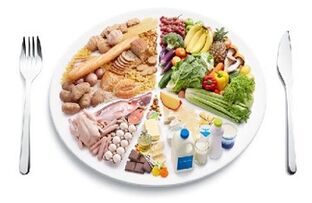
The diet for pancreatitis depends on whether the disease is acute or chronic. Don't forget that pancreatitis is no chore, as it plays an important role in digestion, metabolism and assimilation of substances (proteins, carbohydrates and fats). Hence, immediately after diagnosis, it is necessary to significantly change your diet. If not, even the latest generation of drugs will be powerless.
Acute pancreatitis (reactive)
As its name suggests, illness occurs suddenly (usually right after eating irritating food). Symptoms: abdominal burning pain, fever, nausea, vomiting. Risk factors: lack of protein in the diet, overeating, alcohol abuse, smoking, fatty, spicy, fried food, too cold or too hot, sweet soda. Sometimes the disease is the result of gallstones and chronic cholecystitis.
Nutrition for reactive (reactive) pancreatitis in adults and children ensures maximum rest for the long-term sick pancreas, while reducing the secretion of pancreatic and gastric juice. And this is what the patient's action sequence should be:
- first 2-4 days after exacerbation.It is completely recommended not to eat, but only use medicinal mineral water in small sips and small quantities.
- Starting on Day 5.Gradually and very carefully expand on the diet for pancreatitis. For this you should adhere to the 5P treatment table.
- In 6-7 days.We include in diet jelly, thick soups, kefir, liquid porridge (except millet), steamed chicken, beef and fish cutlets, mashed potatoes and other vegetables in boiled and stewed form, teaweak, baked or mashed apples, rose broth.
Features of the Diet and Sample Menu
No matter where the patient is sent for pancreatitis treatment - to a nursing home or home, he should follow the 5 regimen, based on the following principles:
- Daily norm of vegetable protein - 30 g, animal protein - 50 g, vegetable fat - 15 g, animal fat - 45 g and carbohydrate - 200 g. The total amount of calories consumed for pancreatitis should not exceed 2500-2700 kcal per day. The amount of liquid you drink is 1. 5 liters, salt is 10 g.
- During the first two weeks, we cooked dishes without salt.
- We eat at least 5-6 times a day in small portions to eliminate the risk of overeating.
- The temperature of cooked food should be between 45 and 60 degrees.
- The consistency of dishes is liquid, semi-liquid, i. e. pureed food only.
Diet for acute pancreatitis implies complete elimination from the menu for a long time (almost a year) of bacon, fried food, pickles, sour cream, lard, canned food, baked goods and fresh bread, ice cream, and wine. Compliance with all of the above recommendations can prevent the development of the disease in its chronic form! The sample menu for the day might look something like this:
- Breakfast:steamed scrambled eggs, mashed olives porridge with water, weak tea.
- The second breakfast:cheese with milk.
- Lunch:buckwheat soup, stewed boiled meat, apple jelly.
- Dinner:steamed fish balls, pureed carrots, rose water.
- For the night:kefir.
Chronic pancreatitis
This disease has another unattractive name - pre-diabetes. Indeed, if you've gotten past an unfavorable acute episode (in the absence of proper treatment), diabetes could become the next step. This disease is characterized by two alternating stages - exacerbation and remission. The diet with pancreatitis is therefore aimed at reducing the inflammatory process and, therefore, transitioning the disease into remission.
So from now on, your diet will be a lifelong nutritional system. And there is nothing you can do about it. You can still take the # 5 Diet as a base, the basic principles that we continue to strictly adhere to. Diet with exacerbation of chronic pancreatitis again is a return to the first three steps (abstain from mineral water and add in the list above).
Products approved:
- milk, yogurt, kefir, acid-free cheese, mild cheese;
- porridge (buckwheat, oats, rice), pasta;
- vegetables (potatoes, carrots, pumpkin, zucchini, beets, etc. );
- old flour or white bread biscuits;
- meat (veal, chicken, rabbit, turkey), lean fish;
- baked apple, fruit jelly, berry gravy;
- oat broth, fruit drinks, non-acid juice, chamomile tea;
- pureed vegetable and soup broth, celery juice.
Prohibited products:
- sour fruits, fresh cabbage, legumes;
- spinach, sorrel, turnip, turnip;
- hot spices and herbs;
- fresh bread, cakes, candies;
- sausage, bacon, canned food, eggs;
- meat, fish broth, cabbage soup, borscht;
- alcohol, carbonated sweet drinks;
- candy, ice cream, sour cream, ice cream;
- fried food.






























